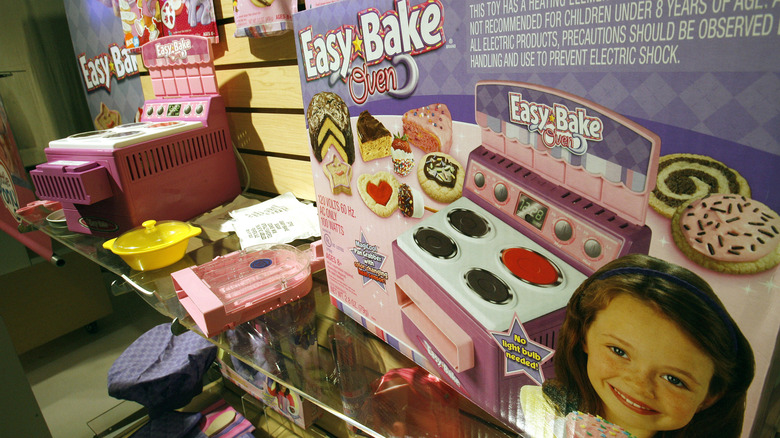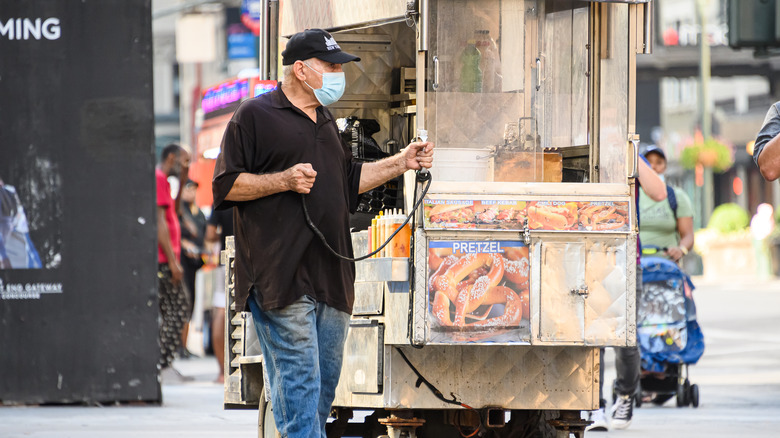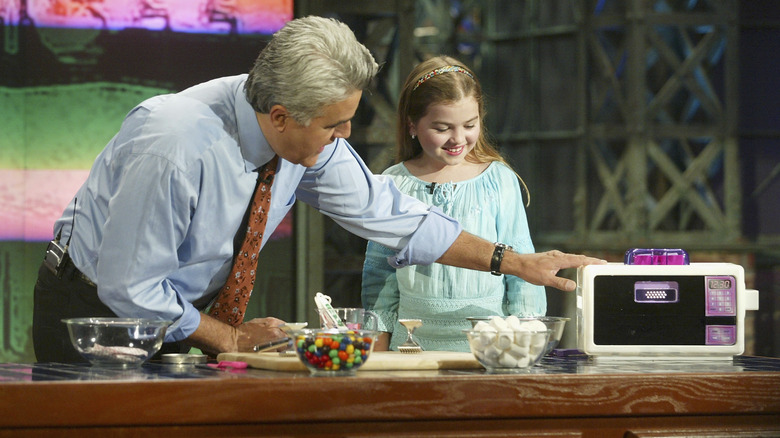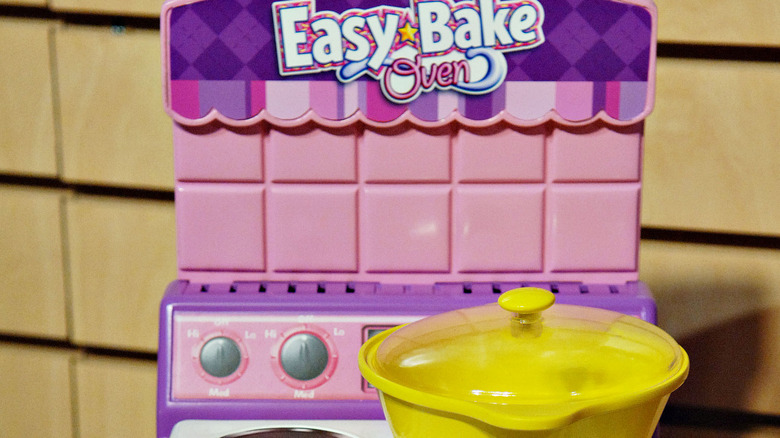What Happened To Easy-Bake Ovens?
Over the years, toys have come and gone in popularity. For example, in the early 1980s, the Cabbage Patch Kids doll craze resulted in long lines at stores, and in some cases, fisticuffs (via The Vintage News). A decade later, parents were fighting it out over Tickle Me Elmo dolls. Other toys undergo brief crazes but remain popular decades later; for example, the Frisbee craze and the hula hoop craze were both decades ago, but both toys can still be found at your favorite retailer's toy section.
Another toy that peaked in popularity decades ago is the Easy-Bake Oven. Unlike other toy kitchen appliances, this device actually got plugged in, produced heat, and — ideally — led to delicious treats produced by their users. It was designed to involve its users in actual baking and even included recipes for making cakes. Unfortunately, it also led to severe burns, and after decades of being a thing, it found itself emblematic of outdated ideas when it came to marketing toys.
Nevertheless, the Easy-Bake Oven is still a thing, and you can purchase one to this day, although it bears little resemblance to the original machines of the 1960s.
Inspired by street vendors
These days, street food is being taken seriously as a culinary art form. But half a century ago, street food was just that: a means of getting a snack on the, um, street. Back in the early 1960s, inventor Ronald Howes — who would also invent Play-Doh and the Spirograph toy — learned about New York food carts from a colleague who had just returned from the Big Apple (via Village Voice). Specifically, Howes was taken by the idea of selling roasted chestnuts from a street cart and how a hot bulb kept the heated product warm, so he set about to replicate the machine in a toy (another source, HowStuffWorks, claims it was pretzels that inspired him).
Of course, the idea of selling America's girls on making roasted chestnuts (or pretzels) at home was a big ask, and Howes and his team at toy manufacturer Kenner set about to making a machine that created tasty treats (brownies and cakes and the like, as opposed to nuts or pretzels). The device heated them with a 100-watt bulb — something that was available readily at every hardware store in the country — and a sensation was born.
How they worked
As mentioned above, the inventor of the Easy-Bake Oven, keen to replicate the ovens of New York City street food carts that used heating lamps, created the machine to use a 100-watt incandescent light bulb as a heating element. As HowStuffWorks explains, the first iteration of the Easy-Bake Oven used two — one above and one below the heating surface (later models, benefitting from improved technology, only used one). In the confines of a metal cube, the temperature could easily reach 350 degrees Fahrenheit, which was enough to cook brownies, cakes, cookies, etc. Further, users could purchase kits so that they didn't have to make the recipes from scratch. Finally, a window allowed the little pastry chefs to watch their culinary creations as they baked.
Despite the simplicity of the machine and its recipes, some young chefs were able to come up with some amazing recipes made in the Easy-Bake Oven. For example, in 2003, 9-year-old Olia Wall (pictured above with Jay Leno) won a contest for her recipe. As ABC News explains, the young lass took mixed ingredients from two of the toy's included kits (butterscotch brownie cookies and blonde brownie mix), added marshmallows and crushed peanut M&M's, and "Marshmallow Cloud on a Heart" was born. For her culinary efforts, Ms. Wall won a $5,000 savings bond.
Severe burns
You may think that a 100-watt incandescent light bulb produces a trivial amount of heat, but if you've ever made the mistake of touching one, you disavowed yourself of that notion pretty quickly. Further, as mentioned above, the temperature inside the ovens could reach 350 degrees Fahrenheit. Unfortunately, the combination of small children and high temperatures equated to severe burns.
As reported by the Consumer Products Safety Commission, one model of the Easy-Bake Oven available in the middle 2000s was so poorly designed that over the course of a few months in 2007, 249 children got their hands and/or fingers caught the machines. Further, 77 children suffered burns from the devices, including 16 second- and third-degree burns. One 5-year-old girl had to have part of her finger amputated. As i-lawsuit reports, almost 100 million units were later recalled.
In 2016, as Fox Business reported at the time, manufacturer Hasbro ditched the traditional 100-watt bulb in favor of a redesigned machine that uses a more traditional heating element, such as might be found in the oven in your kitchen (albeit a smaller and less-powerful one).
Marketed to girls
Back in the 1960s, when Easy-Bake Ovens first became a thing, the matter of how to market it was trivially simple: market it to preadolescent girls. After all, at that time, almost all of the cooking at home was done by women and girls, and the idea of marketing a kitchen toy to boys would have been laughable.
Perhaps surprisingly, Hasbro stuck with that gender-specific marketing until rather recently. Specifically, as the New York Daily News reports, Hasbro's marketing of the toy has been gender-neutral since 2013, and one young New Jersey girl deserves at least some of the credit. McKenna Pope, who was 13 at the time, said that her younger brother loved cooking but didn't want to play with a "girl" toy. The young lass started a petition to convince Hasbro to market the toy to both boys and girls, and with some help from celebrity chefs Bobby Flay and Manuel Trevino — who were both boys at one point — she got her wish. After meeting with company executives, the manufacturer agreed to produce a neutrally-colored (as opposed to pink and purple) machine that included both boys and girls in its advertising.
Easy-Bake Ovens are still around
It's been 60 years, and cultural attitudes have changed over the decades, but the Easy-Bake Oven is still a thing. According to Fox Business, you can still purchase one at your favorite retailer for about $50 (more elaborate models can cost nearly $200). Of course, the machine has changed in a few fundamental ways since its inception beyond its color and shape. The heating element is no longer a light bulb, and the toy is marketed to both boys and girls, rather than just to girls.
Another change to the Easy-Bake Oven wasn't necessarily made to the machine itself but rather to the mixes that users can purchase. With the advent of the internet, parents can now share with each other how to replicate those mixes from scratch and save money in the process, as well as create their own recipes. For example, according to Unsophisticook, a Hasbro-branded cake kit costs $6.99 and only makes two cakes, while the ingredients necessary for it are trivially inexpensive and likely already in your pantry. Made from scratch, the kit can be reproduced at home for 12 cents.





